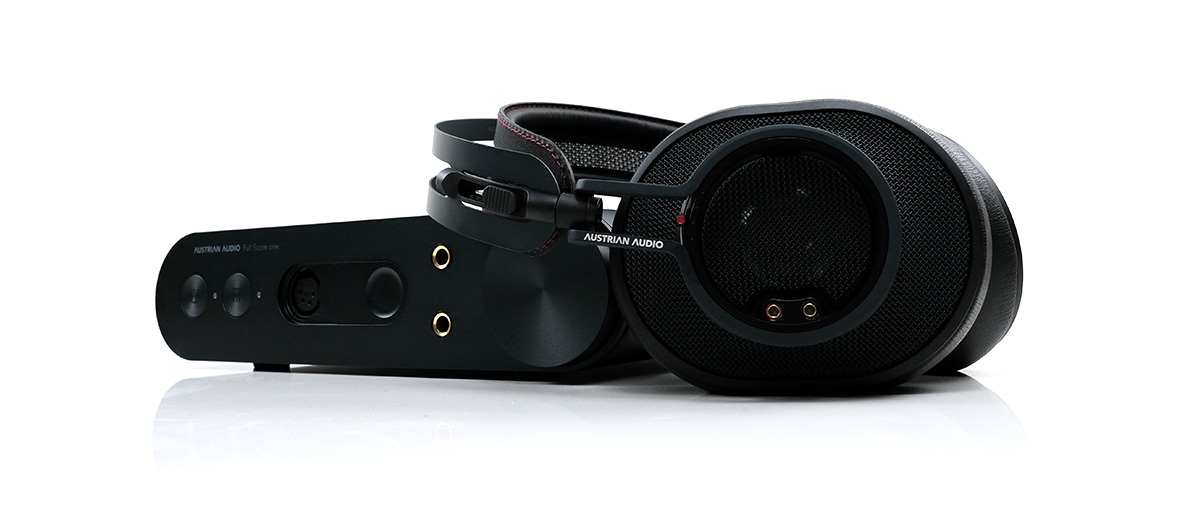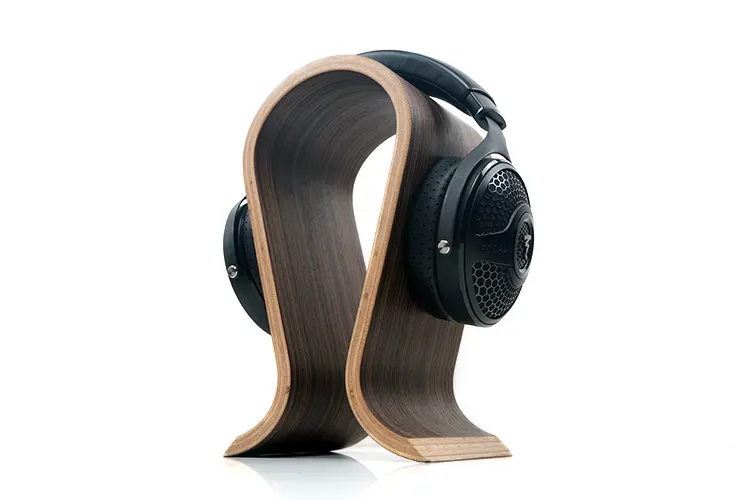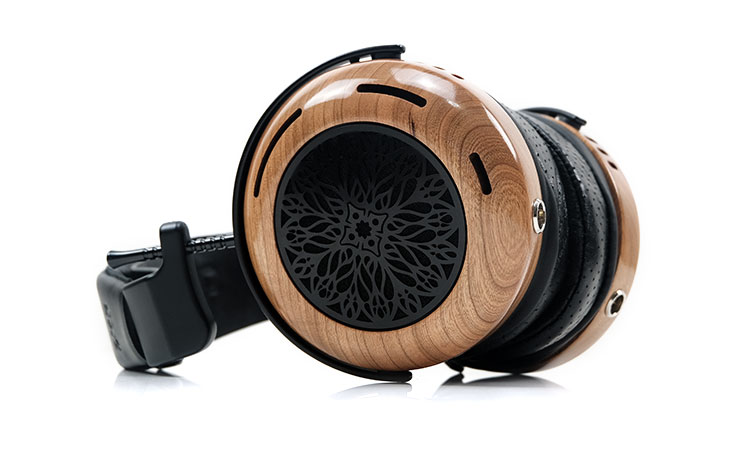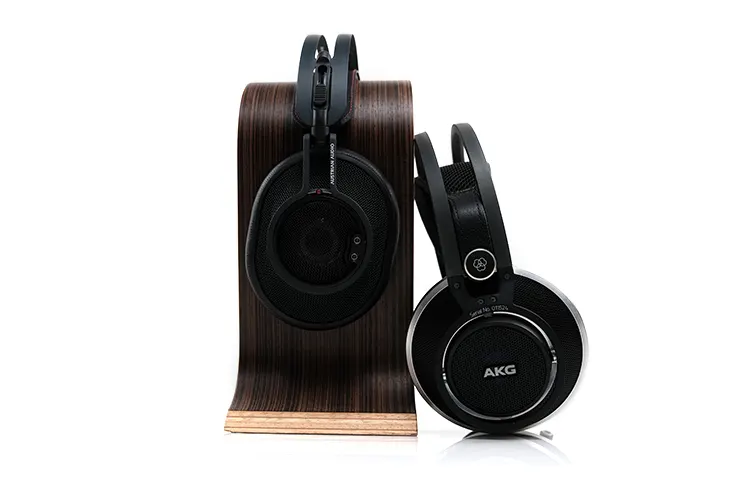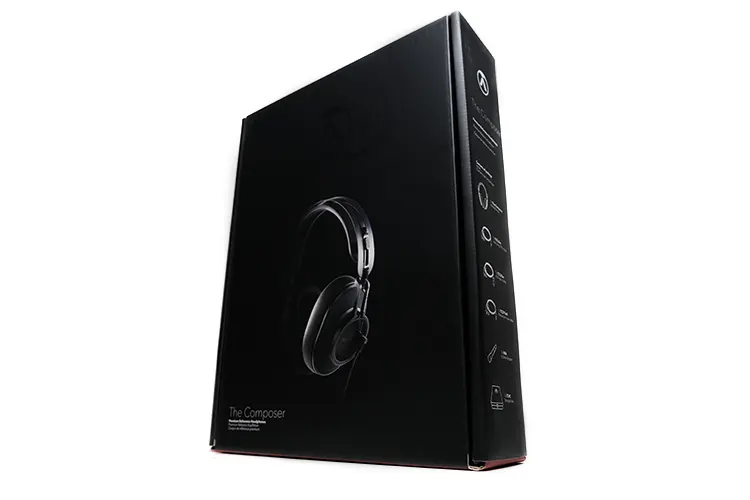Selected Comparisons
The following comparisons to The Composer were completed using a mix of the Full Score One in balanced mode combined with a Shanling CA80 and a Cayin N7, (Pre Out), as the main sources and transport.
Focal Utopia 2022
The Focal Utopia 2022 is the company’s flagship open-back dynamic driver headphones with this version a refresh of the original which was first launched in 2016. The Utopia 2022 also won our 2023 Top Gear Award for best open-back headphones.
Technical
Both headphones are dynamic based with the Utopia 2022 using a slightly smaller 40mm driver with Focal’s signature pure Beryllium ‘M’-shaped dome diaphragm.
This specific version has a voice coil alloy blend of aluminum and copper to keep it light and reliable but it also is a factor in the more relaxed final tuning of the Utopia 2022.
The Composer goes in a different direction with its larger 49mm Hi-X49 DLC or diamond-like carbon diaphragm coating which tightens up the excursion control of the diaphragm and delivers a faster impulse response than their lower-range drivers.
The Composer should be the easier of the two headphones to drive at 22Ω compared to the Utopia 2022’s much higher 80Ω impedance rating.
The Focal’s SPL is rated in terms of mW levels at 104 dB SPL / 1mW @ 1kHz whereas the Composer is officially rated at 112 dB/V @1kHz. An approximate conversion of just under 115 dB/V @1kHz makes the Utopia the more sensitive of the two headphones on paper based purely on SPL.
However, subjectively, the Utopia 2022 needs more juice from the volume dial to match the Composer. A likely knock-on effect from its high impedance rating.
The Focal’s high impedance rating should make it a better match for higher-voltage OTL tube amplifiers. Whereas the Composer will be more suited to amplifiers with stronger current capability for lower resistance levels.
Design
I think both headphones have exquisite modern designs but in terms of outright flexibility and comfort levels, the Composer has the edge.
The Composer has the superior articulation of its ear cups, wider pad openings, and a better pressure-dissipating headband. It also looks more urban to me in its design language compared to the more elaborate Focal design.
The Utopia 2022 is very comfortable but at 490g if feels heavier on my head compared to the Composer. It is also more rigid with less articulation for that nuanced final fit. The classic single headband and memory foam fit can make its presence felt more than the Composer’s wider pressure strap.
The build quality is outstanding on both save for the synthetic leather on the Composer Pads. The Utopia 2022 makes no such compromises with its genuine leather headband wrap and the perforated lambskin memory foam ear pads.
Yes, it costs more than the Composer but in most aspects, the choice of premium materials throughout seems to suggest it should cost more. Appearances count.
Both cables have slightly off-beat connectors, more so the Composer with its banana plug format, which is quite new. The Utopia uses a more established dual-side entry LEMO format but LEMO plugs can be more expensive.
Cable quality on both is topical with the Utopia cables quite long and heavy and the Composer cables a little thin and stiff. Austrian Audio does throw in an additional 4.4mm cable with the Composer which would have been nice with the Utopia package.
Performance
There is a lot of contrast between these two sound signatures and a comparison that does ever so well at exposing the strengths and weaknesses of each other’s tuning.
I have to focus first on the soundstage size because this is where the Composer has a definite edge. Coming from the Utopia 2022 to the Composer staging-wise is a bit like jamming in an underground club and then walking out the door into an open-field concert.
The sense of enhanced space in all directions save maybe pure depth is palatable. The Utopia is thicker, denser, and more accommodating tonally but with a narrower staging shape. It resolves just as well as the Composer with pinpoint imaging but does not sound as wide or tall.
This creates the perception of more space when switching to the Composer. Hot take, I think the Composer might have a little more sub-bass extension also but it has less mid-bass to lower-mid body.
That enhanced body is a major factor in Utopia 2022’s richer more euphonic tone. A tonal quality that is just gorgeous for vocal timbre, especially for those residing in the upper register.
The Composer is much more clarity-focused with a leaner note through the lower register and more 3-5k emphasis pushing percussion energy to the fore. There is more contrast in the Composer’s timbre creating a neutral to somewhat brighter overtone on vocals and higher register notes.
You get a better extension and a lot more headroom from the Composer’s treble. It’s something I prefer over darker Utopia 2022, especially for classical, some synthwave, and arena rock but it can get sharp-sounding if the higher register energy is excessive.
However, for those who prefer a smoother more inviting midrange with a richer instrumental texture, then Utopia 2022 is the better pick.
ZMF Headphones Atrium
The ZMF Headphones Atrium was launched in early 2022 with our review coming out that same year. You can read our full review of the Atrium here.
Technical
This is another dynamic driver comparison, (they all are), with the open-back Atrium driver being almost the same size as the Composer’s at 50mm compared to 49mm.
The diaphragm of each is quite different with the Composer’s Hi-X49 DLC or diamond-like carbon diaphragm up against a composite bio-cellulose diaphragm which ZMF calls a Biocellulose N52 Atrium Tuned Driver.
So-called due to the N52 magnet used to generate a static magnetic field around the Atrium voice coil to create that push/pull effect on the diaphragm.
ZMF has also added what they call the Atrium damping system which has been applied to several headphones in their range recently and not just this headphone. This is a strategically placed internal acoustical damping to control the back-wave acoustical response of the driver to the desired target response.
They also throw in several pad variations as well as an additional mesh option to further refine the tuning options of the Atrium. I use the Titan mesh combined with the stock perforated Atrium leather pads which are the ones that I will be using for this comparison.
Perhaps the biggest technical difference is the load requirements. The Atrium is a 300Ω headphone compared to just 22Ω for the Composer.
It needs more output voltage and sounds ideal on an OTL or SETA-based tube amplifier. The SPL is more or less the same at 96dB/mW, (converted for the Composer), for both headphones.
Design
I think these two headphones provide a stunning contrast both in design language and articulation.
The Atrium is much bigger and the heavier of the two headphones at 490g compared to 385g. It’s a classic single headband with a round cup and matching detachable pads in various leather and suede options as opposed to the svelte and lean aluminum lines, rings, and elongated large opening pleather pads of the Composer.
It’s the striking natural cherry wood grains on the Atrium cups, combined with the elaborated Amiens Cathedral-inspired black aluminum grills, that stand out. Probably more so than the Composer’s relatively low-key matte black metro-vibe.
Low-key does not mean lower quality. I think the design and build approach of the Composer is more sophisticated and better engineered compared to the old-school Atrium frame.
Particularly so with the levels of cup articulation, pressure dissipation, and headband design which makes it the more comfortable and fitting-friendly of the two headphones.
The time it takes to detach the pads on both is a good example. The Atrium can take 2-3 mins depending on how skilled you are in matching the pad edges with the cup grooves. With the Composer, it takes seconds with the magnet system.
The Atrium is quite comfortable to wear but it’s more down to their stellar thick and lush pads than the overall design. The Composer’s design from top to bottom is more holistic for comfort.
I would favor the Atrium’s standard mini-XLR connector options and their cable cloth jacket finishing over the stiffer Composer cable jackets and banana plugs. However, your choices are more limited with the ZMF headphone, (just 1 cable), with additional fees for different plug options.
Performance
Both of these headphones sound divine from the SETA Cayin HA-300 MK2/Holo Audio Spring 2 DAC combo but for differing reasons.
Side by side, the Atrium is the more relaxed and forgiving tonal signature. It’s a little more biased to the midrange, teasing out an intoxicating lush vocal tonal quality within a wide soundstage.
The Atrium is the warmer and the more romantic sounding of the two headphones. The decay lingers a bit more, with the mid-bass and lower-mids progressively lifted providing a richer more euphonic overtone with both vocal and instrument.
Whereas the Composer is airier, deeper, and taller, more resolving with a bit more contrast on an otherwise neutral to natural sound signature from the Cayin. I find it the more complex for staging with better clarity.
I have to say the Composer is not as bright with the Cayin as it was with the Full Score One pairing. The Cayin pushes the Composer more to the sweeter ethereal side of the spectrum providing less body to notes but with superior definition and a shorter decay.
I did find the bass fundamental and separation on the lows more convincing from the Composer. Not so much the general weight of the lower register but rather the dynamics and the noticeable sub-50Hz reach compared to the Atrium which tapers off more here.
The commonality is soundstage with both offering expansive staging qualities. However, I have to give the nod here to the Composer for superior headroom and detail on both ends of the spectrum with stronger sub-bass and upper-treble presence.
AKG K812
The AKG K812 is an older headphone launched in 2014 with a bit of an overlap with the Composer considering some of the original design team from AKG now work under the Austrian Audio brand. You can read our full review of the K812 here.
Technical
These are not the same dynamic drivers. The K812 has a larger 53mm copper-covered aluminum voice coil dynamic driver as opposed to the Composer’s slightly smaller 49mm alternative.
It uses a special air-flow dome at the base of the driver for controlled movement of the driver’s compound diaphragm, (compound curve shape), combined with a 1.5T magnet system.
I am not sure the technology was available at the time for AKG to be able to make a similar coating to the Composer’s Hi-X49 DLC, (diamond-like carbon diaphragm).
Despite the different approaches to each headphone’s driver implementation both offer relatively easy-to-drive numbers.
The K812 is rated at 36Ω as opposed to the Composer’s slightly lighter load of 22Ω and an SPL of 110 dB/V @1kHz which is just 2 dB less than the Composer at 112 dB/V @1kHz. You should not find too much of a difference in their performance relative to power from modern headphone amplifiers.
Design
The synergy in design language is very close between these two headphones. You can tell some of the minds behind the K812 were also behind the Composer.
From the dual flat metal headband arch to the tight mesh on the front of the cups and that very distinctive low-profile circular mount and cardanic hinge system incorporated into both headphone designs.
However, aside from the ear pads on the K812 which were ‘genius-level’ at the time, the Composer feels like the K812 has been taken to a higher level.
The Composer hinge system pivots on a single rod rather than the K812 non-articulating dual bar frame. You get some good vertical movement from the K812 but limited lateral movement compared to the most 360-degree articulation on the Composer.
I prefer the elongated cups of the Composer over the more traditional round design of the K812. However, I wish Austrian Audio could find a way to bring in some of the K812 ear pad designs in a magnetic detachable format.
They weigh the same, the comfort levels are more or less the same also. The one caveat is the different pad system.
The unique shaped pads of the K812 are made of protein leather with memory foam. They are designed in such a way as to give more space on the inside than the outer rim opening.
They fit more securely compared to the Composer pads but the edge on the K812 pads might dig into your head a bit more over time compared to the Composer’s softer edging.
The cables on the K812 are not great. Single-ended only, rubber jacketing, and expensive 3-pin LEMO connectors. Not that the Composer banana plugs are anywhere near standard but at least you get balanced XLR and 4.4mm options in the box.
Performance
The soul of the K812 somewhat exists in the Composer, but the newer far outclasses the older on both a tonal and technical level.
For this comparison, I switched back to the Full Score One in TTT single-ended mode using stock cables. Right away you can tell the low-end of the Composer from around 80hz down to 20Hz has a much better presence, generating more power and a better note fundamental compared to the K812.
As a result, the K812’s lower register and some midrange notes lack a bit of firmness and solidity. I would subjectively describe it as sounding like the notes float along with the pace and rhythm of the music, whereas the Composer delivers the same notes with more attention-grabbing conviction.
The K812’s mids around 1-3k also lack the same forwardness as the Composer equivalent. So, not only do they just ‘float along’ but they tend to get overwhelmed from a peakier 4-6k range which in turn, exhibits a lot of upper-order harmonic overtones from a stronger upper treble lift.
The Composer doesn’t suffer from that type of treble tuning with a smoother denser tone to both vocal and upper register instruments.
Granted the Composer is still neutral to slightly bright in the upper mids and goes north of the Harman Target Response curve around 5-6k. However, it carries less of the K812’s shrillness into the upper-midrange timbre courtesy of a gentler upper treble tuning.
Also, I tend to find the Composer generally more resolving in the high frequencies whereas the K812 sounds more ‘masked’ in the same region despite it being somewhat of a brighter tone.
Our Verdict
The Austrian Audio ‘The Composer’ is an impressive high-end set of dynamic drive headphones tuned with a reference-like focus on clarity and resolution. It has its eye firmly fixed on audiophiles who value detail and a high degree of accuracy in their listening preferences.
This is a set of headphones that is easy enough to drive out of just about any source. However, I was particularly impressed with smoother-sounding desktop amplifier pairings such as the Bartok Apex and the Cayin HA-300MK2.
There will be those who will quibble on the highs and wish for a bit more warmth from the mids. That can be system and recording-dependent to some extent so mixing and matching components in any demo situation might be valuable to those with a more treble-sensitive ear.
I cannot finish this conclusion without mentioning these are some of the best-built modern-looking headphones out there today and up there with the likes of Meze and Dan Clark Audio’s high-end offerings for comfort.
Overall, the Composer has enough about it physically and audibly to put the ghost of the K812 firmly in the rearview mirror.
Austrian Audio The Composer Specifications
- Construction: Over ear, open back
- Frequency range: 5 Hz – 44 kHz
- Sensitivity: 112 dB/V @1kHz
- THD (@ 1kHz): < 0.1%
- Driver size: 49mm
- Impedance: 22 Ω
- Input Power: 160 mW
- Detachable cables with Banana Jack (included):: 3m with 3.5 mm Jack Plug (TRS)/3m with XLR 4pin/1.4m with 4.4 mm Pentaconn style
- Adapter included: 3.5 mm to 6.3 mm
- Dimensions: 215 x 200 x 90 mm
- Weight (without cable): 385 g

